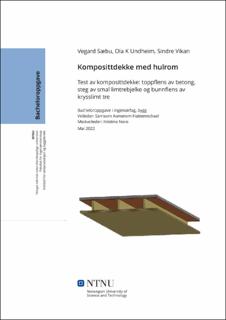| dc.contributor.advisor | Asmerom Habtemichael, Samsom | |
| dc.contributor.advisor | Nore, Kristine | |
| dc.contributor.author | Sæbu, Vegard | |
| dc.contributor.author | Undheim , Ola K | |
| dc.contributor.author | Vikan, Sindre | |
| dc.date.accessioned | 2022-07-23T17:19:58Z | |
| dc.date.available | 2022-07-23T17:19:58Z | |
| dc.date.issued | 2022 | |
| dc.identifier | no.ntnu:inspera:106258180:112687818 | |
| dc.identifier.uri | https://hdl.handle.net/11250/3007999 | |
| dc.description.abstract | I denne bacheloroppgaven undersøkes hulromsdekke med toppflens av betong, steg av smal limtrebjelke og bunnflens av krysslimt tre. Undersøkelsen er en videreutvikling av komposittdekker hvor betong er støpt rett på krysslimt tre. Videre er målet med undersøkelsen å se på om dekket kan spenne lenger enn tradisjonelle tredekker, og samtidig bruke mindre materialer enn det som brukes i dag for å bidra til å nå FNs bærekraftsmål.
Forskningen er gjort med kvantitativ metode med håndberegning i regneark, og FEM-analyse i Abaqus. Miljø og kostnadsberegning er utført ved hjelp av Norsk prisbok utviklet av Norconsult.
I denne oppgaven blir det lagt stor vekt på beregning av effektiv stivhet for å benytte i brudd og bruksgrensetilstand. Det vil si bruddkontroller, vibrasjon og nedbøying. Noen brann-kontroller blir også utført. Laster dekket blir utsatt for og andre variabler tar utgangspunkt i at dekket skal benyttes i et kontorbygg. Anslag på pris og klimaanalyse blir gjort for å se om dekket kan være konkurransedyktig. Store deler av oppgaven er beregnet etter den nye EK5 og denne oppgaven kan være til hjelp på å tolke denne standarden på kapitler om ribbedekke, gammametode, nedbøyning og vibrasjon.
Da det ikke har latt seg gjøre å beregne svinn ble det lagt god margin på nedbøyningskravet, men fortsatt er det usikkert på hvor stor nedbøyning det vil bli. Med henholdsvis toppflens av 70 mm armert B30 betong, HBV-shear connector, 48X300 mm S-bjelke som steg (GL28) med C/C 600 mm og bunnflens av 3-sjikts KL-tre 3⋅20 mm av C24 og C14 er det mulig å spenne opp til 11 meter. Økes tykkelsen på sjiktene med KL-tre til 3⋅30 mm er det mulig å spenne opp til 12 meter. Materialbruken blir redusert sammenlignet med alternativer. Utslipp halveres nesten sammenlignet med hulldekke av betong på tilsvarende spenn. | |
| dc.description.abstract | This bachelor-thesis looks at hollow-cores with top flange made of concrete, steps made of glulam beams and the bottom flange made of cross laminated timber (CLT). The research is a continuation of composite decks where concrete is poured directly on CLT. The thesis will be a continuation of this and will look at if the hollow-core is able to span a further distance than traditional wooden decks, and simultaneously use less materials than what is used today to reach the FN´s sustainability goals.
The research was done with a quantitative method with hand calculation in spreadsheets and FEM-analysis. Environmental- and cost calculations were done with the help of the Norwegian Pricebook made by Norconsult.
This thesis puts a large emphasis on the calculation of effective stiffness to be used in ultimate- and serviceability limit state. This means fracture checks, vibrations, and deflections. Some structural fire design were also researched. The loads the hollow-core is put under, and other variables is defined to be used in an office building. Price estimations and environmental analysis is done to see if the composite deck can be competitive. Large parts of the thesis are calculated based on the new EC5, and this thesis can also be of help in understanding the new Eurocode. Especially in the chapters covering ribbed decks, the gamma method, deflection, and vibrations.
Since there has been no way to calculate the shrinkage, a large margin was used on the deflection limit state, but there is still some uncertainty on how large the deflection will be. With respectively a top flange of 70 mm B30 concrete with rebar, HBV-shear connectors, 48X300 mm S-beam as the web (GL28) with C/C 600 mm and the bottom flange made of CLT 3⋅20 mm with layers of C24 and C14 the cover can span up to 11 meters. If the thickness of the CLT is increased to 3⋅30 mm, there is a possibility of a span up to 12 meters. The material usage is decreased compared to other alternatives. Compared to a hollow-core concrete deck, the emissions are reduced by almost 50%. | |
| dc.language | nob | |
| dc.publisher | NTNU | |
| dc.title | Komposittdekke med hulrom | |
| dc.type | Bachelor thesis | |
